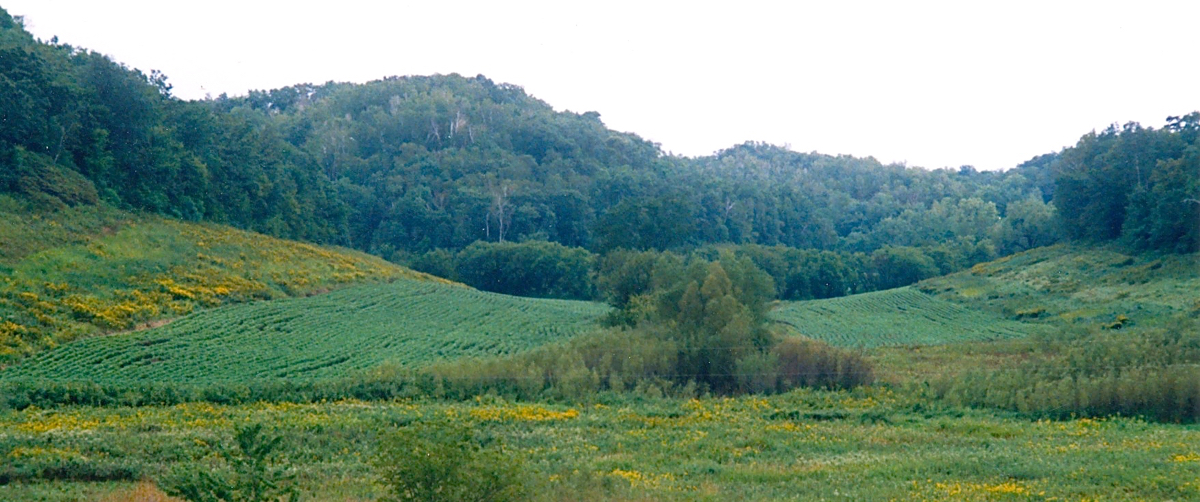Before the European settlers arrived, the landscape in this area consisted of dry rocky prairies on south-facing points, oak savannas on the tops and sides of the hills, dry oak woodlands on north-facing slopes, and sedge meadows and wet prairies in the valleys surrounding spring-fed creeks.
Our land was a dairy farm beginning in the mid-1800s until about 1970. More than 150 acres of it was planted with crops, and cows were grazed throughout the woods and on the prairies. After 1970 there were no more cows, the cropland was rented out to be planted with corn and soybeans, and the land was rented for deer hunting.
Here’s the view looking north from the road in the summer of 2000, just after we bought it.
Except for the 150 acres of former crop fields, and another 15 or 20 acres of abandoned hayfields, the rest of the land is mostly remnants of the pre-settlement landscape. We’ve been trying to read the clues – looking at the terrain and the plants that still grow here to figure out what it would have been like before it was farmed. Once we decide what it might have been like, we work to restore that habitat.
In deciding what to work on, we choose areas that are in fairly good shape to start with – ones that have enough native plants and habitat structure to indicate what they used to look like. We hope that by encouraging the growth and expansion of these habitats, they will spread into neighboring areas that may not be in such good shape.
Following are the kinds of remnants we have, and the kinds of work we do on each. Each one has a link to photos and examples of the kinds of work we do on those remnants and why, and links to how we use different techniques.
Dry bluff prairie – We have 5 large south-facing points which all have dry, bluff prairie vegetation. Aspen and birch trees have invaded the sunny prairie hillsides, and brush has filled in beneath the trees. Our goal in these areas is to remove the invading trees and shrubs. Some of the hillsides are very steep, so the work goes slowly.
Mesic Prairie – We have at least two flat, sunny areas that were never plowed and still have prairie vegetation. There are also many small prairie openings, usually surrounded by overgrown savanna, that have enough sun that they still have blooming prairie plants. With all these areas, our goals are to cut back the invading trees and shrubs, and let the prairie plants thrive.
Savanna – Nearly all the woods on the tops, and the south, east and west facing sides of the points is actually remnant savanna. These areas have many big, old Burr, White and Black Oaks, with prairie/savanna plants growing under them. We’re working to get rid of smaller trees and shrubs so the structure of the woods is more like savanna, and the plants under the trees can get more sun.
Woods – Most of our valleys open to the south, so most of the woods that covers the sides of those valleys is actually savanna. Maple Ridge is an exception. It’s a ridge that runs east and west, and the north-facing slope faces the bottom of our Center Valley. Some of the other hillsides have small areas on their slopes that face north. These north-facing woods have probably always been wooded with what is often called dry oak forest. The trees are mostly Black, Red, White and Burr Oak, with a sprinkling of Red Maple, Basswood, and Elm. Maple Ridge is unusual in that about a third of it is covered by a dense grove of Sugar Maples.
Wetland – Little Waumandee Creek runs across the front of our land, and the flat valley bottom along its sides is, or was, wetland. Drain tiles were installed in many places, long ago, but they’re starting to break up so the ground is getting wetter. Wet prairie and sedge meadow vegetation still grows in much of this area, but it’s been invaded by several aggressive wetland invasive plants.

